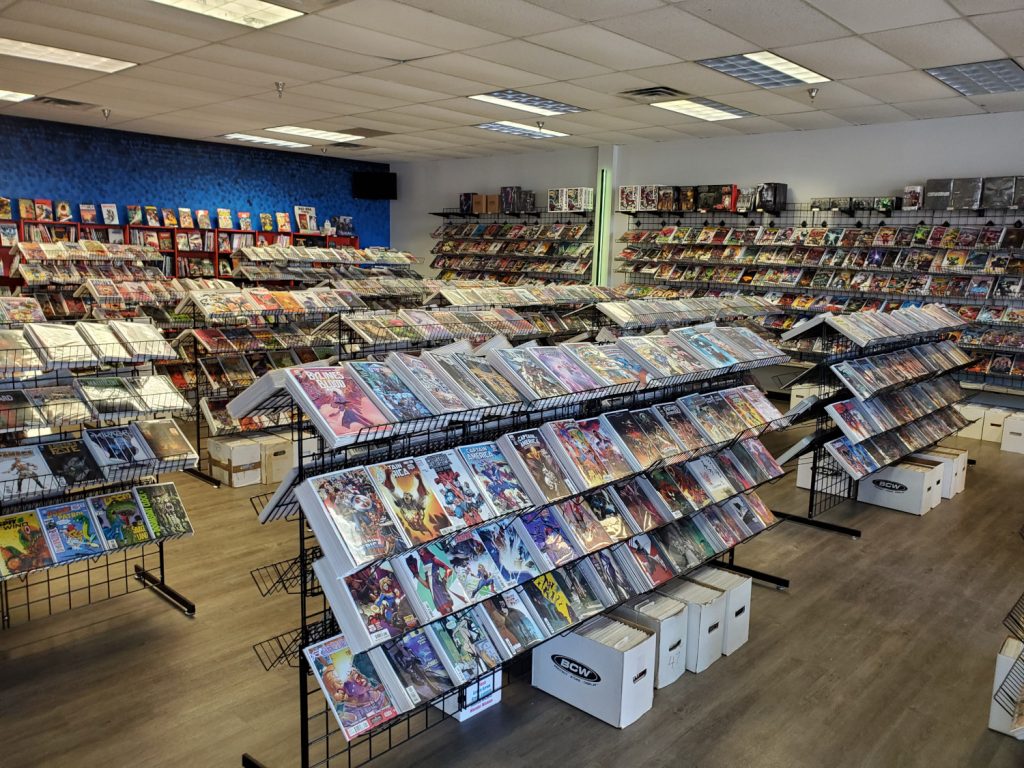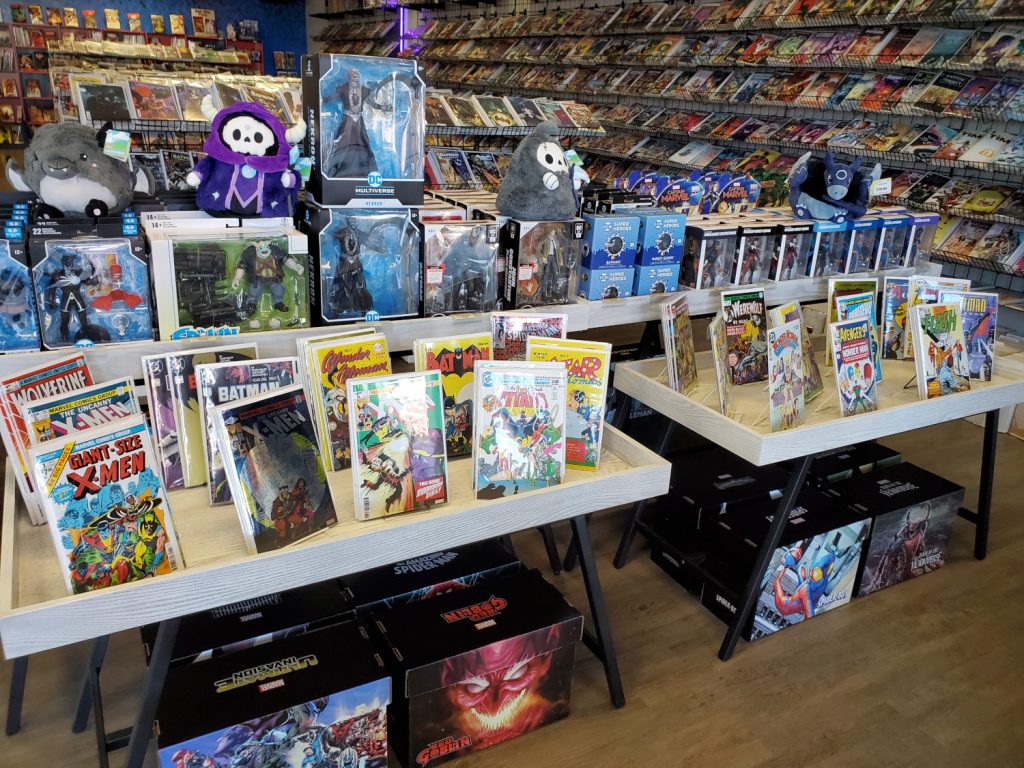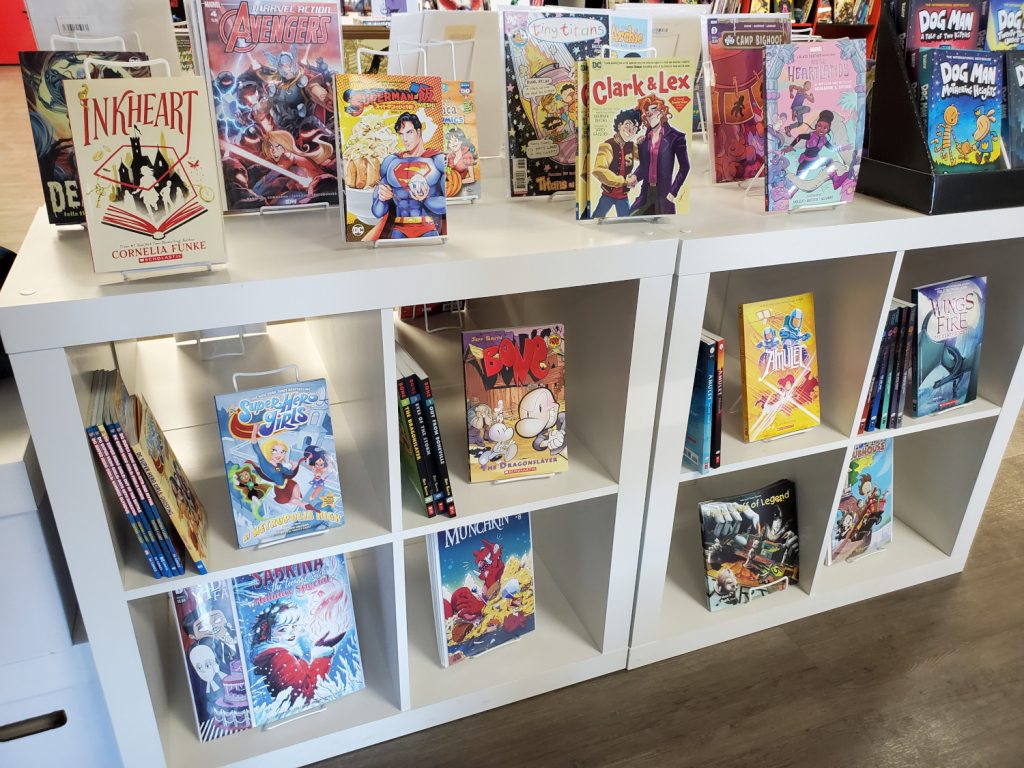“We Kept Growing After That Wave”: Retailer Dan Wallace on the Continued Growth of Impulse Creations
Every comic shop is different.
That’s something I noted in my recent feature on how 2023 was for retailers, and it’s an important note when considering the overall conversation about the direct market. There’s no such thing as a representative comic shop, with each standing out as a singular example relative to their peers. While there may be similarities, unifying factors that connect many of them what they see and experience is different than what others see and experience. That’s why I suggested in that piece that some shops likely did worse and others did better than those I talked to. With a couple thousand comic stores in the direct market, anything is effectively possible — even if I hadn’t heard from anyone who crushed it in 2023.
That is…until now.
After that piece went up, a retailer named Dan Wallace reached out to me. He owns and operates Tulsa, Oklahoma’s Impulse Creations Comics & Collectibles, and he wanted to share his story with me, one of massive success in 2021, solid gains in 2022, and a 2023…that continued that trend instead of reversing it. That intrigued me, and led to me looking into the shop. After digging through its online and social presences, I was impressed by what I found, a shop that had a smart approach at building its audience and excitement in those customers.
As we’ll get into, Impulse Creations started online before eventually moving into a brick and mortar location, creating a hybrid model in the process, and one that’s just grown and grown in recent years. More than that, the shop is doing it in unexpected ways relative to the norm these days, thriving with single issues, direct communication with customers, and even promotional efforts that extend beyond their regular customers. I had to know more.
So, recently, I interviewed Wallace about his views and approach to running a comic shop, and what’s leading Impulse Creations to see such strong results. It’s an expansive conversation about something worth celebrating — a comic shop that’s finding a way to thrive right now — and how they’re finding that success these days. You can read it in full below. It’s been edited a bit for length and clarity. And because it’s kind of a natural extension of my recent retailer feature, it’s even open for non-subscribers. If you enjoy this conversation, though, consider subscribing to SKTCHD to read more like it and to support my work in the process.

Alright, let’s start at the beginning, Dan. What’s Impulse Creations’ origin story, and given all the flavors of comic shop you could make, what made this the right direction you wanted to go in for your store?
Dan Wallace: To be honest, we started by listening to our customers and following their lead rather than starting with a big plan and following that over the course of years. Impulse Creations started in 1998 as a bare-bones website selling duplicates of comics from my personal collection, as I’d bought two copies of a lot of new comics in the 80s. This was when Amazon was still just selling books, so it was fairly early days for an online store. Mine was nothing more than a single, static webpage with a list of comics for sale.
Many of those sold quickly though, so, rather than just selling off the comics for some extra cash and being done as I’d originally intended, I saw the potential and decided to reinvest in buying some collections to then grade and re-sell. That cycle continued, but I started having customers ask about new comics. It made sense to start offering those as well, so I set up a wholesale account and began adding new comics to my inventory.
Shortly after that, I hired my first staff member as I needed help keeping up with orders, which my wife had been assisting with until then. At that point, we were located in an office building since everything was still online. However, we started having local customers ask if they could pick up their orders in person to save on shipping. There was no reason to refuse but, as that became more frequent, staying in our office space location no longer made sense. So we moved into a street facing retail location.
Since then, we’ve expanded into the space next door and added lines like action figures, statues, gaming, prose books, novelties, and more, but almost almost every aspect of our evolution has been because we saw a need or interest from our customers. It’s always been about listening and figuring out what we can do to better serve them.
So, it sounds like you still have one foot in the online business and one in the brick and mortar side. What’s a bigger part for you? Is it pretty equal, or does one side of the business lead?
Wallace: That’s always a little hard to determine because we really push preorders and subscriptions to get the data we need for ordering. The more subscription and preorder activity we see on a book, the more additional copies we order beyond that for the shelf. Because of that though, a very high percentage of our sales to local customers are placed online even though they pick up in store, making it difficult to separate from online orders that get shipped to customers around the world.
That being said, we’re roughly 35% local and 65% non-local since there are a lot more people outside easy driving distance from us than there are inside that range.
Okay, something you said there is very interesting to me. If I’m understanding you correctly, online interest can guide what you order for the shelf? Is that right? Do you find that this approach helps you get a better idea of broader interest and helps you find potential strong sellers with more confidence?
Wallace: Exactly.
With long-running titles, sales history is a big factor in our ordering but there are fewer and fewer of those these days due to all the relaunches. We could (and to some extent do) use our own judgment to make best guesses about quantities to order but that’s prone to often ordering too many or too few.
By collecting as many preorders and subscriptions as possible though, we have a good idea of what customers themselves want and can extrapolate the needed number of shelf copies based on the preorder demand.
Of course, there are still surprise hits that leave us scrambling to try and restock and there are books that don’t get huge preorders but we have faith in so we order more but early demand from customers is our best forecasting tool when there isn’t enough sales history to go by.

So it seems that in a lot of ways, the online side of your business informs your physical store, and vice versa. Do you find that to be the case?
Wallace: I’d say it’s more that I think of them as one and the same. Both local and non-local customers use the same system to place orders and manage subscriptions whether they pick up orders in store or have them shipped. The data we get from those advance orders is used to determine how many additional copies we order but those additional copies could ultimately be purchased in-store or ordered online. We just know that the more advance orders we have, the more copies we’re also likely to need after the book is released.
You told me privately that 2023 was a good year for your shop, which was not a sure bet for everyone. What was your year like, and how did it compare to 2022 in particular?
Wallace: When the pandemic started and Diamond closed for two months, I made the decision to up our game to overcome whatever changes were coming. That’s when I invested in our latest store expansion, really amped up our social media presence and other advertising, and started reaching out to publishers and creators to help build closer relationships.
A lot of stores saw a sales drop at the start of the pandemic, and that was followed by a surge as customers received money from the government but didn’t have access to a lot of outside social activities to spend it on. We saw the same thing, but we were also really pushing just how exciting comics are and making sure our customers knew about each cool new release and what publishers had coming their way. I feel like those factors allowed us to not only ride the wave but build on it so that we kept growing after that wave started to falter.
2021 was our largest year over year sales growth in our history at 38% over 2020 but 2022 was up by 7% over 2021 and 2023 was up by 6.9% over 2022. Of course, expenses like payroll are up as well but this sales growth allowed us to maintain and grow our staff to help implement new initiatives and better serve customers both in-store and online.
We have our customers to thank for that growth by showing their faith in us and for letting us know what they want so we can work to provide them with it. I also give thanks to publishers and creators for producing some of the best and most innovative comics in recent memory that’s made getting customers excited easy for us.
It sounds like you have a solid product mix, even beyond comics. What’s your split by product? Do single issues lead trades and graphic novels? Are back issues a big part of what you do? What’s driving things for Impulse Creations?
Wallace: Single issue comics are what we started with and they remain my personal passion, so it’s no surprise that they continue to be our biggest sellers. We’ve expanded in a lot of areas to meet the needs and desires of as many customers as possible but it really comes down to being all about the stories.
With those stories having been designed largely around trade paperback collections for years though, we’ve certainly seen a lot of growth in that area. Graphic novels have a long way to go to eclipse single-issue comics for us but there continues to be more growth in that category than anywhere else.
As for back issues, our store has a bookstore-style layout that minimizes the number of comics in back-issue bins by having as many as possible on aisles of face-out shelves. This includes most comics from the 80s to the present (the majority of issues older than that tend to be more valuable and are displayed elsewhere). The benefit of this is that there are so many older comics that are great stories but few people are looking for them by title as back issues, especially mini-series and series that are no longer being published. They catch customers’ eyes on the face-out shelves though and sell much better than they otherwise would.

One thing I really love about what you just said and the photos of your shop is how almost everything is face out. All the new comics, displays for graphic novels of all ages, and there’s even a significant amount of your full graphic novel stock that ends up getting the face out treatment. That in my experience is pretty rare, and I think that’s super smart. Was that a point of emphasis for you? If so, how do you think it helps entice customers, and do you think maximizing that is more valuable to you than maximizing on floor inventory?
Wallace: That was a big part of my goal with our latest expansion. Comic stores inevitably have a tremendous amount of inventory which is great for selection but leads to a lot of things being out of sight and out of mind.
We’ve always had our full inventory available online with search filters for characters (i.e. filtering for “Spider-Man” will bring up issues of Marvel Team-Up) which helps but there’s nothing like just seeing a comic or graphic novel and having something about the cover grab you. Whether you’re digging through back issue boxes or browsing online, you mostly only find what you’re looking for but miss a lot of things you didn’t know you wanted. Space to put as many items face out is a luxury that many comic stores don’t have and we certainly couldn’t do this when we started out. But years of building up our customer base has allowed us to reach that point and it’s one of my favorite features of our store.
As far as maximizing showroom inventory goes, we do still have back issue boxes out front too. They just don’t dominate the sales floor. Between those and the face-out shelves, we have at least one copy of almost everything accessible. Since literally everything is online as well, in-store customers can also easily search for something on their phone while shopping and have someone on staff pull it for them if they can’t find it.
What’s working for you? Are there any specific comics, graphic novels, creators, publishers, or anything else that’s really speaking to your team and customers these days?
Wallace: That changes every month as there always seems to be at least a few new titles that really hit big. Some that are past their first issue though and still really going strong are Wonder Woman, Beneath the Trees Where Nobody Sees, Skybound’s Energon Universe titles, Punisher, Barbaric, Poison Ivy and Green Lantern.
Some that may not be exceeding expected sales levels but that we feel are really something special and deserving of attention include Unnatural Order, Gerry Duggan’s Invincible Iron Man & X-Men titles, Beyond Real, The Devil That Wears My Face, Local Man, The Hunger and The Dusk, and Star Trek.
You never know what’s coming up down the line but we have high hopes for Ghost Machine, Helen of Wyndhorn, Top Cow’s relaunches of Witchblade and The Darkness, Todd McFarlane’s expansion of the Spawn Universe, as well as Mad Cave’s new Flash Gordon books.

That’s a solid mix of books, some of which are broader hits and some of which aren’t necessarily. Do you have a sense as to what builds excitement in comics for your customers? How do you move the needle when new books hit the shop?
Wallace: I try not to think of our customers as a group. Between the fact that we’re located next door to an indoor trampoline park that brings in a lot of families with children and the fact that we ship everywhere means that our customer-base is very diverse.
Certainly, the best sellers of the industry tend to do well for us also but virtually every comic published is going to appeal to at least one of our customers. Rather than pre-judge and say that something isn’t likely to sell to our client-base, we simply offer everything, promote as much as we can, and order based on the feedback we receive. That doesn’t mean that we literally stock at least one copy of every new comic but we present them all as preorders and often get surprised when orders come in high on a new title that we might otherwise have not stocked at all or only ordered a small quantity of.
We started out by following our customers’ lead and that continues to be the case when it comes to stocking new comics.
One thing I really like about your approach is how you’re very big on letting customers know when orders are due and how they can make sure that they don’t miss out on…well, pretty much anything. Do you have a sense as to how much of an impact those FOC pushes and awareness building efforts and calls to action have on driving sales both in store and online?
Wallace: The newsletters and social media promotions we do when new publisher catalogs are made available and around each week’s FOC are huge for us. Those are our single greatest sales tools, especially when publishers and creators like or share them.
With so many comics in each month’s catalog or even limiting it to just the ones coming out each week, customers can easily miss ones they’d definitely want if they only knew about them. We break it all down to focus on single publishers, weekly FOC, and even highlight specific books. I wish we could literally highlight everything on an item by item basis but there are only so many hours in a day. As it is though, the smaller groups we’re able to focus on do a good job of getting most everything seen and we receive a surge in preorders every time one of those goes out.
That’s massive. To be honest, while there’s a lot of great comics these days, it can be, as you noted, difficult to keep up with all of them, and that’s a huge part of the challenge for shops. So, while that direct engagement is a lot of work, it’s undoubtedly paying off for you. What’s the key to getting the most out of that for you? And by that, I mean not just getting the information out to customers, but activating them so they don’t just know what’s coming but pre-order it?
Wallace: As you said, it is a lot of work but no one ever claimed that running a comics shop was easy. Like most things in life, you get out of it what you put into it so it’s worth it to me to put in that effort. Some things work so we keep doing them or find ways to do them even better. Some things don’t work so we look for an alternative. I strongly believe that everything has a solution though and usually more than one so we’re always trying new things. It’s all part of evolving and keeping up with the times and technology.
As for getting the most out of product promotion, I know from talking to fans that some of what we do results in sales that go to other stores. Plenty of customers have a local shop they love and they buy there after getting excited about something they saw us promote.
That’s perfectly okay with me though. The fact that they saw our post or read our newsletter means that a connection of some sort has been established. Even if they never buy from us in the future, they might mention us to a friend who lives in our area, visits here, or is looking for an online store. Social media is all about connections with one thing leading to another so just being active and getting things out there is often enough.
Our FOC and new release posts tend to be pretty much to the point and convey information concisely though which is key to encouraging someone to click through and, hopefully, purchase or ask for the item the next time they’re at the store. On the other hand, when commenting on or reposting things from creators and publishers, I sometimes have a bit more fun and I apologize to those without a sarcasm gene for that.
Related to that: How important to the success of both sides of your business is building excitement? Do you think building and maintaining that energy is your secret sauce in some ways?
Wallace: I think it’s very important but I also think that excitement comes largely from the comics themselves. I could hype oatmeal all day long and probably not generate a sale from it but comics are easy to get excited about because there’s something really cool everywhere you look. It’s all about taking what’s there, finding what’s appealing about it, and letting people know.
Connecting those dots isn’t the easy one, two, three that this makes it sound like but it’s the process I try to follow.
Beyond the comics themselves though, we try to make the store an exciting place to visit. We set up signings whenever we can, we have music and led colored lights to create ambiance (we changed them all to red and black when Sam Witwer visited), we’re always rearranging things to keep the store fresh, and have staff that make customers feel welcome.

Everything can’t be a hit every time, nor can everything work out 100% of the time. That’s certainly the case for anyone running a comic shop. Have there been any notable challenges that have stood out to you? And if so, what have you been doing to try and overcome those?
Wallace: I’m glad you used the word “challenges” as I prefer that to “negatives” or “problems.” Certainly, things occur that aren’t always what I would have chosen but, as I mentioned earlier, I think everything has a solution. When something comes along that seems like it could have a negative impact, I try to look at it from all angles and figure out how to work around it at a minimum or, better yet, how to use it to our advantage.
One example would be DC’s move to Tuesday as their release day. Having two days on which to put out new comics at first seems like extra work but we did it from the start to see what the results would be.
Just putting out the books and doing nothing else would very likely have had little effect but we promoted that second day of new comics and continue to do so every week to make sure our customers know about it. We’ve seen DC sales grow as they have a day largely to themselves (both in-store and via online promotion of the release day) while we’ve also seen those Tuesday shoppers purchase other items on their visits which increases our sales even beyond just the added sales from DC.
It does take a bit more processing time but it’s very minimal since it’s mostly the same work for staff but just split across two days. The benefits though have far exceeded that cost.
The comics industry has changed a lot in just the last few years and if we kept doing things the way we always had despite those changes, we almost certainly would have seen sales and profitability decline. Instead, we embraced those changes and found ways to work with them to do things better, more efficiently, and to better serve the needs of our customers.
That’s how we approach every new bump in the road.
You mentioned working directly with publishers and creators. What does that entail, and do you have a sense as to the impact that’s had on your business?
Wallace: There’s no one-size-fits-all to working with publishers and creators as everyone does things differently but simply having an open line of communication is invaluable. Everyone we’ve made contact with knows they can reach out to us anytime to let us know what they have coming up so we can help promote it. The more in touch we all are, the more we can capitalize on each other’s efforts to get the word out on what’s new and to reach a wider audience.
Sometimes we get advance looks at books. Sometimes it’s phone or Zoom meetings to discuss things either privately or with groups of other retailers who also do this sort of outreach. Sometimes it’s in-person meetings at conventions. Sometimes creators send us posters, bookmarks, signed items, etc.
I always tell everyone though that there’s no such thing as too much information so feel free to flood our in-box. We may not be able to use everything but it’s better to have it and not use it than to not have it and miss out on something that could be useful.
There’s a wide range of things that happen but networking is always beneficial and sometimes pays off in ways we never would have expected. Everyone we work with knows that, as long as their project is good, we’ll get behind it and promote it to as wide an audience as possible.
A book does have to be good for us to stake our reputation on it as our customers wouldn’t trust what we have to say if we mindlessly promoted everything. Fortunately, the vast majority of comics are objectively “good”. That doesn’t mean that every comic will appeal to every reader but it’s our job as a comics retailer to work to find the readers for each book.
One challenge we do have from being located in Oklahoma though is store signings since most everyone in the industry lives on one coast or the other and we’re nowhere near them. With luck, building these connections will lead to some solutions for that as well so we can bring more creators in to meet fans who would otherwise never get a chance to see them in person.

You say there’s no such thing as too much information, but one thing I hear from creators both publicly and privately is how it can be hard to know what the right information to share with shops is. For you, what moves the needle most? Are there things that creators send you that consistently help you generate interest in the work?
Wallace: I think the real key is providing an answer to the question, “Why?’
Comics used to have covers that answered that question. Batman is in chains with someone aiming a gun at him. Superman is dying of Kryptonite poisoning. Spider-Man is struggling to fight Doctor Octopus while he’s got a broken arm in a sling.
Why should you buy that comic? Because now that you’ve seen that tease, you have to know what happens next. Covers rarely do that these days so we need another way to make a potential reader want to find out more. Sure, an Artgerm cover will sell a book too but not every comic can sell based solely on a nice cover so let people know the hook. Every story should have something cool, special, or exciting going on inside the cover so focus on that even if you have to tease it to avoid spoilers.
Obviously every shop is different, just like every customer is. What works for you won’t necessarily work for others. But given your experiences and the challenging times many in the direct market are going through, it does seem like maybe there could be tactics that could translate for other shops and at the very least are worth trying. So, with that in mind, Dan, let’s pretend I’m another shop trying to figure things out. Are there any specific tactics or approaches that you’d recommend for me, things that you’ve noticed as particularly effective for your business overall?
Wallace: I’m going to have to largely pull on some other things I’ve said here to answer that. It’s important to listen to your customers but not cater to one group at the expense of another. Be open to trying new things. Don’t get hung up on one way of operating when something potentially better comes along.
Most of all, have fun! Your enthusiasm should translate to your customers.
I often ask shops about what has them excited about what’s coming up in comics to close these chats, and that seems extra important for you, because in a lot of ways, your formula seems like it’s built on building excitement through the energy you and your staff bring about the comics themselves. So, as we move into the second month of the year, and with what seemed like a strong slate of headliners in January, what has you excited about comics and the job of running Impulse Creations?
Wallace: Well, I’ve already talked about some of the comics that I think have strong potential coming up. I’m a huge personal fan of Geoff Johns so I’d be excited about what Ghost Machine has coming even if there weren’t so many other tremendous talents on board.
I can’t wait to see how Skybound’s Energon Universe expands and evolves.
Tom King and Daniel Sampere’s Wonder Woman continues to be exceptional issue after issue and DC as a publisher is very conscious of the market and is carefully listening to customers in much the same way we are.
Publishers like AWA (I love anything from J. Michael Straczynski), Vault, Mad Cave, and more may not always get as much attention but they keep putting out truly phenomenal comics from creators at the top of their game and I expect to see some of these really take off.
Honestly, I just have to look at the next week’s FOC list or the next month’s preorder catalog to find more things to get excited about.
Beyond the individual comics coming out each week, in July I’ll be at SDCC touching base again with many of these publishers and creators and getting re-energized for the second half of the year.
On that note, I sometimes hear about energy and enthusiasm for the hobby waning. It’s not uncommon for both comics readers and even retailers to feel that what they read in the past was better but that’s far more perception than reality. People feel the same way about TV, movies, music, and other forms of entertainment. All of those things have changed but I enjoy both new and old versions of all of them. They each have their strengths and weaknesses but, as a whole, forms of entertainment don’t get worse over time since they rely on the public enjoying them for their existence and have to respond to the current market.
It’s all about finding the comics that suit your tastes because they are definitely out there no matter what those tastes are.
Personally, I love comics as much as I ever have and I don’t see that changing any time soon.
Thanks for reading this interview. If you enjoyed this conversation, though, consider subscribing to SKTCHD to read more like it and to support my work in the process.
